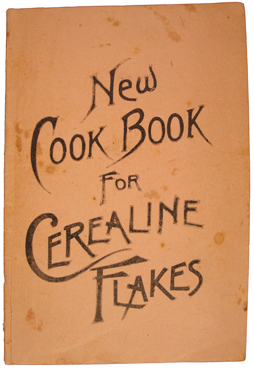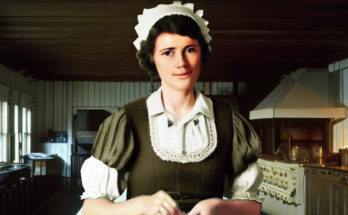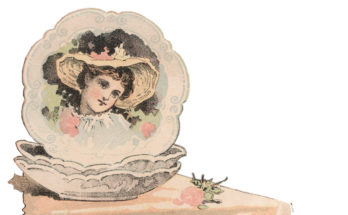1888: New Cook Book for Cerealine Flakes; This Cook Book contains a Few Selected Recipes for the Use of Cerealine Flakes. They Will Be Found Economical and Palatable. Cerealine Manufacturing Co., Columbus, Indiana.
These are only a very few Favorite Recipes for Preparing Cerealine Flakes (made from selected white corn.) in Dishes for Breakfast, Lunch, Dinner, and Supper.
Cerealine Waffles
1/2 pint of scalded “Cerealine” (cold), 1/2 pint of water, 3 eggs, 3 tablespoonfuls of sugar, 1/2 teaspoonful of baking powder, 1/2 teaspoonful of vanilla, 2 1/2 cupfuls of flour.
Mix the eggs and sugar together thoroughly; then add 1/2 pint of scalded “Cerealine,” vanilla, water, flour and baking powder. Lemon extract may be used instead of vanilla, and milk instead of water, to suit the taste; butter may also be used if desired; serve with powdered sugar.
16-page booklet. Publisher: Cerealine Manufacturing Co.
The history of manufactured cereals is interesting for Cerealine, as they’re one of the earliest creators of manufactured cereal–
- 1863. The first manufactured cereal was Granula (not Granola) by Dr. James Caleb Jackson as a health food for his sanitorium in upstate New York. It was made from Graham flour containing wheat’s bran, germ, and endosperm — a nutritious concoction! and baked twice (like hard tack) to remove moisture so it could keep. It had to be moistened before eating.
- 1879 Cerealine began as a brewer’s product in the 1860s manufactured at T. & J.W. Gaff & Co. The edible cereal flakes may have been the brain child of mill worker, James Vannoy, employed there*.* True or not, the owner of the mill, Joseph Franklin Gent took out the patent for the cerealine flaking process for edible cereal in 1879 (six years before wiki claimed that it was Vannoy’s discovery–but dates could be off). Later, company was called Gaff, Gent, & Thomas Co., then the Cerealine Manufacturing Co. They merged with others to form the American Hominy Company in 1902. Cerealine was made from white maize or Indian Corn by first removing the bran, germ, and “the impurities” creating a granular product. Then they steamed the resulting grits to both soften and strengthen them without cooking. Their unique invention was to warm-roll the wet granules to dry them and make them into thin flakes, and to cover their bases another patent submitted to broadly state that it was to press and dry the starchy particles into thin flakes. Cerealine Flakes needed 1 minute of cooking by the consumer before eating, perhaps similar to quick rolled oats for today’s oatmeal.
- 1893 Shredded Wheat, third manufactured cereal, the invention of Henry Perky of Denver, Colorado. Shredded Wheat had its debut as a cereal machine company looking to sell the cereal machines to homemakers to make cereals in their own kitchen. It wasn’t popular, but it did catch the attention of the Kellogg brothers, giving them exciting knowledge for cereal manufacturing,–but that’s another story. Perky, out of frustration, decided to make cereals instead of selling the machines and that turned out very well for Perky!
- Finally we get to Kellogg, c. 1894. I won’t get into their history as that is well-covered elsewhere. But I believe they were trying to reformulate the 1863 Granula and ended up tweaking it and calling it Granola. This was a different type of cereal than the Granola many of us know from the 1970s, it just has the same name. They also used a roller method, a la Cerealine Flakes, I believe, and created their corn flakes in 1894 .
- 1900 Muesli…. and on and on it goes in the creations of new cereals and methods of manufacturing them. Today, most cereals are extruded. This process was used to make noodles as early as the 1700s, as Thomas Jefferson created a diagram of a noodle extrusion machine that he saw in Europe.



